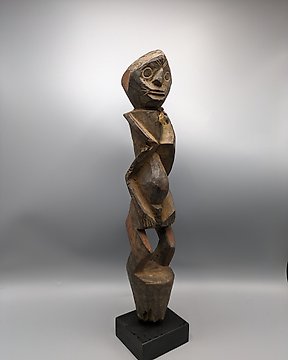
Chamba - Nigéria
Nr. 84048231

Nr. 84048231

A large Wurkum or Mumuye sculpture, Northern Nigeria, Bénué river, no legs, no arms, a column-shaped neck with a protruding adam´s apple and a cord necklace, the round head with a sketchy face, perforated circular eyes, the ears are represented by two large flaps; a dark patina, partly shiny, hard wood, traces of ritual use. Certificate of origin and provenance.
"The largest and most ethnically and geographically complex of the Benue subregions is the Middle Benue. During the first half of the nineteenth century, the establishment of Muslim Fulani states and the simultaneous intensification of slave raiding dramatically impacted the diverse peoples living there. These events were followed by further disruptive outside influences in the form of British colonization and the arrival of Christian missionaries starting in the early twentieth century.
Most contemporary ethnic identities within this area crystallized only during the colonial period, because the British needed them for administrative purposes, and local people embraced them out of a sense of belonging. The works of more than ten of these culture groups -with an emphasis on the Jukun, Mumuye, Chamba, Wurkun/Bikwin, Goemai, Montol, and Kantana/Kulere - are featured here.
Distinctive to the arts of the Middle Benue region are sculptures in human form, hybridized human-animal horizontal masks, and remarkable vertical masks that may have functioned as “walking sculptures.” The striking resemblances among these art objects speak to historical relationships and ritual alliances among neighboring peoples. All across the region, wooden figures served as intermediaries in rituals aimed at healing and protecting the community, especially from such crises as epidemics, drought, and warfare. And, horizontal and vertical masks were used in performances associated with funerals and remembering the dead, initiating youth, ensuring or celebrating a successful harvest, or healing the sick." Fowler Museum.
Lit.: Frank Herreman and Constantine Petridis: The Discovery of Mumuye Art. In: Frank Herreman: Mumuye: Sculpture from Nigeria. The Human Figure Reinvented, Milan 2016.
Hogyan vásárolhatok a Catawiki-n?
1. Fedezzen fel valami különlegeset
2. Tegye meg a legmagasabb licitet
3. Fizessen a biztonságos és védett rendszert használva